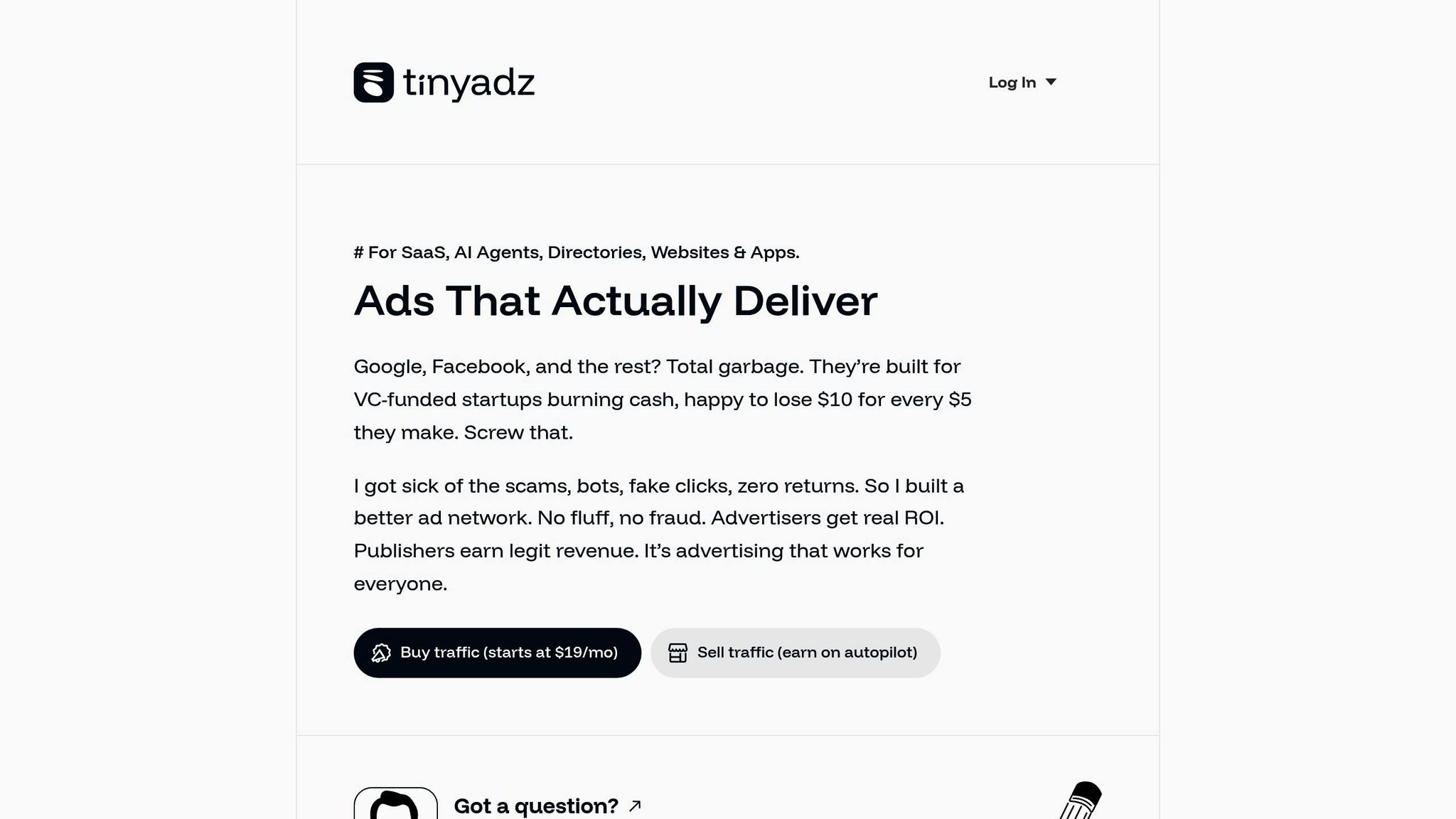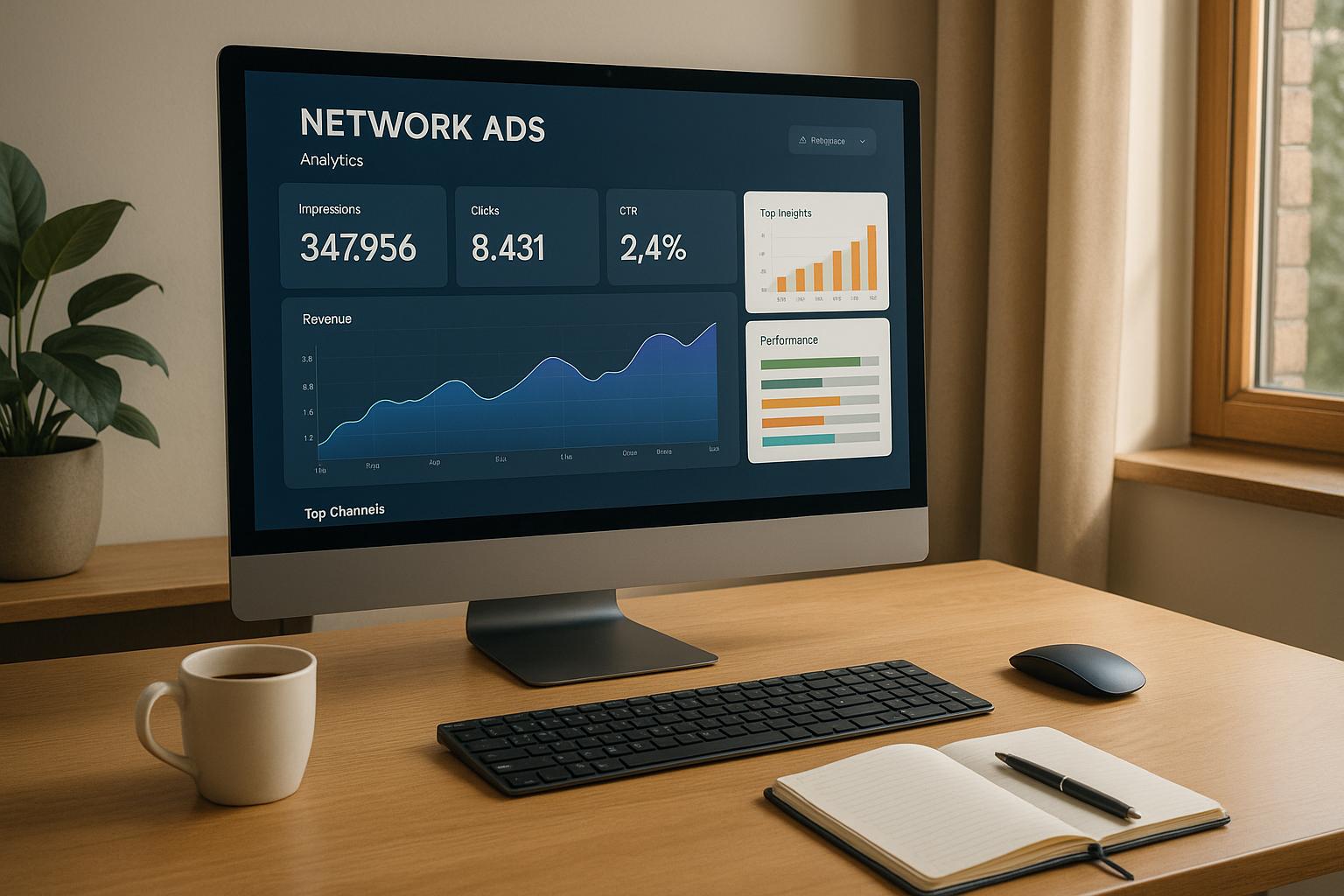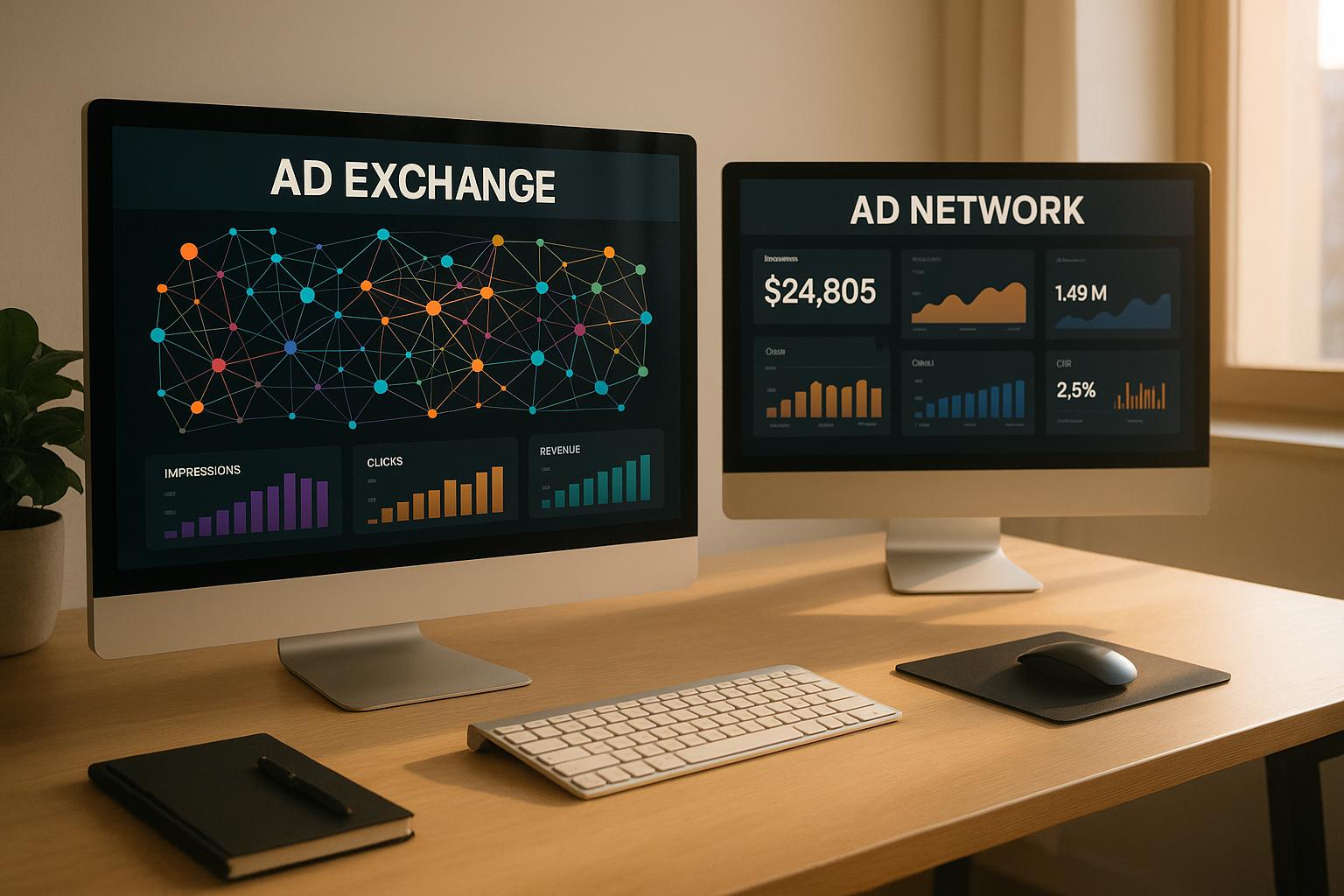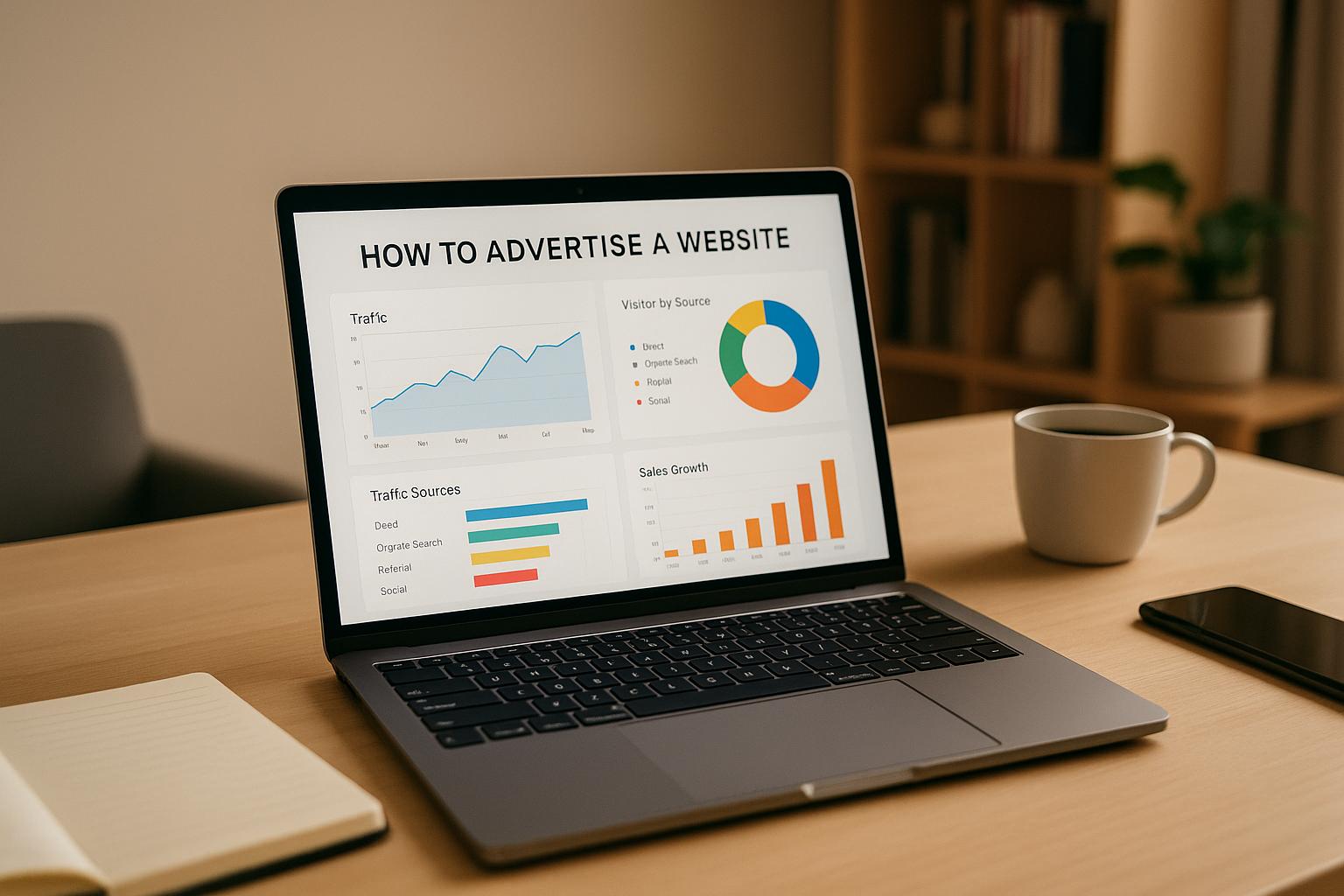Digital publishers must understand advertising revenue because it’s the backbone of monetization in today’s online landscape. With global ad spending projected to hit $910.2 billion by 2027, publishers have immense opportunities to grow revenue through smart advertising strategies. Here’s what you need to know:
- Advertising supports content creation: 75% of small publishers say they couldn’t create as much content without ad revenue.
- Hyper-targeting drives results: Ads tailored to specific audience segments improve engagement, trust, and ROI.
- Balancing ads with user experience is key: 88% of users won’t return to a site with intrusive ads, but 83% are open to relevant, non-intrusive ads.
- Diversify ad formats: Use banners, newsletters, social media, and event sponsorships to maximize revenue.
- Privacy compliance matters: With privacy laws covering 85% of the global population by 2025, first-party data and privacy-first advertising are critical.
Publishers who focus on targeted ads, user satisfaction, and data-driven strategies can create sustainable revenue streams while maintaining audience trust.
How Most Digital Publishers Make Money
How Hyper-Targeted Advertising Works
Hyper-targeted advertising tailors messages to specific audience segments, blending personalization with precision. This approach not only boosts revenue but also ensures a smoother, more relevant user experience. Let’s dive into how this strategy outshines traditional methods.
What Hyper-Targeted Advertising Means
Hyper-targeted advertising relies on detailed data - like demographics, location, interests, and behaviors - to craft marketing messages for specific groups. Advanced algorithms and analytics play a key role in delivering these customized campaigns. On the other hand, traditional advertising takes a broader approach, aiming to reach as many people as possible. Think of it like a billboard on a busy freeway: it’s visible to many, but it may not connect with individuals on a personal level.
Here’s a quick comparison of the two approaches:
| Aspect | Hyper-Targeted Ads | Traditional Ads |
|---|---|---|
| Targeting | Focused on specific audience segments | Broad, general audience |
| Data Usage | Leverages detailed analytics and insights | Relies on basic targeting methods |
| Performance | High engagement and ROI | Lower engagement and ROI |
| Cost Structure | Higher cost per click/impression | Lower cost per click/impression |
| Primary Goal | Drive conversions and maximize ROI | Build general brand awareness |
Why Hyper-Targeted Advertising Helps Publishers
The real strength of hyper-targeted advertising lies in its ability to improve engagement and build stronger connections with both audiences and advertisers. When ads align with users’ interests and behaviors, they feel more like helpful suggestions than interruptions. For instance, a study by Marketo found that using behavioral targeting led to a 56.68% increase in open rates and a 147% boost in click-through rates. Personalization also has a big impact, with revenue per user increasing by up to 166%, and 79% of people preferring ads that are relevant to them.
This relevance fosters trust and improves user satisfaction, while advertisers benefit from measurable success. Data-driven insights and effective tracking make it easier to justify premium ad rates.
A great example of this is Deutsche Bahn’s “No Need to Fly” campaign. By using geotargeting and AI to deliver personalized price comparisons, the German railway company saw an 850% increase in click-through rates and a 24% jump in sales revenue.
"Hyper-precision targeting is a powerful, high-impact, low-waste approach to audience-first marketing that drives engagement, conversion rates and lifetime value."
– Geoff Crain, Senior Director of Sales & Marketing, Kingstar Media
Hyper-targeted strategies not only improve campaign performance but also integrate seamlessly into broader monetization plans, creating a win-win for publishers and their users.
How TinyAdz Makes Hyper-Targeting Easier

TinyAdz takes the complexity out of hyper-targeted advertising, offering publishers tools to monetize their content without technical headaches. By focusing on verified traffic, personalized matchmaking, and transparent reporting, TinyAdz ensures advertisers connect with real, engaged users.
Verified traffic helps eliminate wasted ad spend by filtering out bots and fake clicks, building trust between publishers and advertisers. Meanwhile, personalized matchmaking aligns advertisers’ offerings with the interests of specific audiences. This approach is backed by data showing that 86% of consumers are influenced by personalized messages when making purchase decisions.
TinyAdz also provides a range of monetization options, including banners, newsletters, and social media ads. With no minimum traffic requirements, even niche publishers can tap into advanced advertising strategies. By handling the heavy lifting, TinyAdz allows publishers to focus on what they do best: creating content that resonates with their audience.
Working with Niche Brands and Advertisers
Once you've fine-tuned your hyper-targeted strategies, the next step is forming partnerships with brands that align with your audience. These collaborations can drive revenue while delivering real value to your readers. But building these relationships requires more than just placing ads - it's about creating partnerships that resonate on a deeper level.
Finding the Right Advertising Partners
To succeed in niche advertising, you need to focus on brands that naturally fit your audience's interests. This starts with a data-driven approach to uncover opportunities that others might miss.
- Keyword research is essential for identifying lucrative niches. Tools like Google Ads' Keyword Planner can help you spot industries - like health, legal, or tech - where advertisers pay top dollar for clicks.
- Market size data gives you a sense of which niches have long-term potential. For example, the men's grooming and beauty market is expected to hit $115 billion by 2028, while the pet industry could grow 7% annually through 2030. Even markets like stationery, often overlooked, represent a $158 billion opportunity.
Stay ahead of trends by setting up Google Alerts for key terms in your niche or keeping an eye on social media chatter. Resources like Think with Google and Nielsen research can provide insights into shifting consumer habits that advertisers are eager to tap into.
The goal is to find that sweet spot: niches with decent traffic but less competition. These are often underserved areas where advertisers are willing to pay a premium for visibility. Once you've identified potential partners, it’s time to build relationships that last.
Building Long-Term Advertiser Relationships
Finding the right advertisers is just the first step - how you approach and maintain these partnerships is what truly matters. Your focus should be on building relationships that go beyond one-off campaigns.
- Understand their goals. Advertisers want more than ad space; they want brand recognition and new customers. Show them how your platform can help achieve those goals. This positions you as a partner, not just a vendor.
Niche publishers have a unique edge. Jay Senter from Shawnee Mission Post explains:
"People really value the fact that we're providing reliable coverage of their communities. And they recognize that all of our sponsors are local, too. So when someone signs up for an ad or sponsorship package with us, they're attracted not just to the price for the exposure, but to the ability to be associated with a well-regarded local brand".
Building trust is key. Wendy Cohen from Berkeleyside highlights the importance of personal interaction:
"A direct salesperson makes the process seamless, works on the client's behalf and is the person who provides trust and comfort to what can be a daunting experience, particularly for a small business person".
Niche communities thrive on authenticity. They value their sense of belonging and are often skeptical of generic marketing. To connect, your ads must reflect their language, tell relevant stories, and address their specific needs.
Here are some examples of successful niche campaigns:
- Fenty Beauty collaborated with LGBTQ+ beauty creators on Reddit's r/MakeupAddiction. By showcasing inclusive shade ranges through tutorials, they achieved 3.2x higher engagement rates compared to traditional ads.
- REI created native content for outdoor sports subreddits, including gear guides for climbing and hiking. They also hosted "Ask Me Anything" sessions, resulting in click-through rates four times higher than the platform average.
Offering varied advertising options can also make a difference. Whether it’s sponsorships, native content, or interactive campaigns, giving advertisers flexibility sets you apart. Platforms like TinyAdz simplify the technical side, letting you focus on building meaningful connections with brands that align with your audience.
Finally, transparent communication is non-negotiable. Share performance metrics, audience engagement stats, and targeting capabilities openly. Smaller publishers often see higher engagement rates than larger platforms, and this can be a major selling point.
As Kenny Katzgrau from Broadstreet puts it:
"Focus on the advertiser and all else will follow".
When you genuinely help brands connect with your audience, the results will speak for themselves - and the revenue will follow.
sbb-itb-957fd63
Methods for Increasing Revenue Through Ad Campaigns
Once strong advertiser relationships are in place, the next step is to focus on strategic methods to increase revenue. Publishers who experiment with a variety of ad formats while keeping their audience engaged often see better results than those relying on just one approach. Using diverse ad formats opens up opportunities for data-driven and creative campaign strategies.
Different Ad Monetization Options
To maximize revenue, publishers should tailor their ad formats based on their audience's size and behavior. A mix of formats can be far more effective than sticking to a single method.
Banner advertising remains a staple for many publishers. Placement is key - ads positioned above the fold get more visibility, while in-content placements encourage engagement. Industry stats show that the average click-through rate for Google Ads is 3.17%, but well-optimized banner ads can perform even better.
Social media monetization offers unique potential for publishers with active online communities. Platforms like TinyAdz allow publishers to integrate campaigns seamlessly into their social feeds, making them feel natural to users. This strategy works especially well for audiences eager for product recommendations.
Newsletter monetization has grown in importance as email marketing continues to deliver strong returns. Publishers can include sponsored content, dedicated ad sections, or product promotions within their emails, all while maintaining the tone and authenticity that subscribers value.
Event-based advertising is another high-impact option. For publishers hosting webinars, virtual events, or community meetups, this format can be especially lucrative. Sponsors often pay a premium for access to highly engaged, niche audiences, making it a great fit for B2B publishers or professional networks.
Diversifying revenue sources not only shields publishers from market ups and downs but also creates a stronger financial foundation.
Using Data to Improve Campaign Performance
Data analytics takes the guesswork out of ad campaigns. Publishers using advanced analytics are 23 times more likely to attract customers and 19 times more likely to turn a profit.
"Data analytics is more than a buzzword; it has the power to unlock deeper audience insights, optimize ad strategies, and drive higher engagement." – Lineup
Metrics like click-through rates and conversions help identify underperforming campaigns, allowing for quick adjustments. Audience segmentation is another critical tool - it enables publishers to serve highly relevant ads by tailoring them to specific demographics, behaviors, or locations. Personalized ads, especially those targeting psychographics, can increase click-through rates by up to 50%.
A/B testing is invaluable for fine-tuning campaigns, from the design of the ad to its placement and call-to-action. Meanwhile, predictive analytics uses historical data and machine learning to forecast outcomes and allocate resources more effectively. Currently, 60% of companies use A/B testing, with another 34% planning to adopt it.
Understanding user behavior is also essential. Tools like heat maps and click maps can reveal which parts of a page grab attention, helping publishers optimize ad placement.
Comparing Different Ad Campaign Types
Each ad campaign type has its own strengths, making it important to weigh the trade-offs before choosing a strategy. Factors like audience size, engagement levels, and technical capabilities play a big role in determining what works best.
| Campaign Type | Revenue Potential | Audience Engagement | Implementation Difficulty | Best For |
|---|---|---|---|---|
| Banner Ads | Medium-High | Low-Medium | Low | High-traffic sites, broad audiences |
| Native Advertising | High | High | Medium | Content-focused platforms, engaged readers |
| Newsletter Sponsorships | High | Very High | Low | Email lists, loyal subscribers |
| Social Media Campaigns | Medium | High | Medium | Active communities, lifestyle content |
| Event Advertising | Very High | Very High | High | Professional networks, B2B audiences |
| Programmatic Display | Medium | Low | Low | Large-scale operations, automated systems |
Native advertising stands out for offering a less intrusive experience, often leading to higher click-through rates than traditional banners. However, it demands careful integration to align with the publisher's content and the advertiser's brand.
Programmatic advertising, which is projected to account for 81% of digital ad revenue by 2028, automates the buying and selling process. This approach works best for publishers with high traffic, as it allows for scalable and efficient optimization.
To further boost revenue, consider using multisize ad placements to increase competition for ad slots. This strategy can drive up revenue per impression. Additionally, implementing lazy loading improves page speed and ensures ads load efficiently without disrupting the user experience.
The key to successful monetization isn’t about cramming as many ads as possible onto a page. Instead, it’s about striking the right balance between generating revenue and maintaining a positive user experience. Publishers who achieve this balance are better positioned for long-term growth alongside their audience.
Tools and Best Practices for Publisher Revenue
The right tools and strategies can turn monetization challenges into opportunities. Publishers who prioritize advanced technology and adhere to privacy regulations set themselves up for long-term success in a competitive market. These tools and practices build on established strategies to boost ad revenue without sacrificing user experience.
Important Tools for Effective Monetization
To effectively monetize digital assets, publishers need a well-rounded toolkit that combines hosting, content creation, analytics, and specialized advertising platforms. The most successful publishers use platforms tailored to their specific needs.
Key components include digital asset management systems, efficient content workflows, secure authentication, flexible monetization options, customer relationship management (CRM) tools, and actionable analytics.
For example, TinyAdz offers a comprehensive suite of features, including detailed reporting, personalized advertiser matchmaking, and solutions for monetizing traffic on all sites. Its reporting tools provide clear insights into campaign performance, helping publishers track revenue and spot opportunities. The platform’s matchmaking system connects publishers with advertisers that align with their audience demographics and content themes, while its traffic solutions make monetization accessible to smaller publishers, regardless of audience size.
Commerce media platforms also play a crucial role by linking publishers with premium brands. These platforms offer seamless integration and access to substantial advertising budgets, showcasing the revenue potential available to publishers who choose the right partners.
Another critical advancement is advertising platforms that operate without third-party data. Cookieless advertising solutions ensure user privacy while still delivering targeted campaigns. Alongside these tools, publishers must prioritize compliance with data privacy regulations.
Following Data Privacy Regulations
Compliance with privacy laws isn’t just about avoiding fines - it’s also a way to build trust and gain a competitive edge. Publishers who adopt a privacy-first mindset not only protect their users but also strengthen relationships with both audiences and advertisers.
By 2025, privacy laws will cover 85% of the global population, making compliance a necessity. Companies that prioritize privacy are already seeing a 160% return on investment, proving that profitability and compliance can go hand in hand.
To ensure compliance, publishers should start with a thorough privacy audit. This includes reviewing consent mechanisms, third-party partnerships, and any AI applications. Adaptive consent management systems can help maintain compliance without disrupting user experiences.
As privacy laws become stricter, first-party data becomes even more valuable. Publishers can use this data to create personalized content and seamless integrations that don’t rely on external tracking. This shift benefits publishers with direct audience relationships, offering new ways to engage users.
Privacy-focused revenue models also open up new opportunities. Contextual advertising, for instance, delivers relevant ads based on content rather than user data. Premium subscriptions and exclusive memberships provide direct revenue streams without relying on extensive data collection. AI can further enhance contextual relevance while respecting user privacy.
For publishers with international audiences, investing in regional infrastructure and localized consent mechanisms is essential to navigate varying regulatory requirements. As data sovereignty efforts grow, especially in the Asia-Pacific region, staying compliant across borders becomes increasingly important. Beyond compliance, keeping up with digital advertising trends is key to staying competitive.
Staying Current with Trends and Testing
The digital advertising world is constantly evolving, and publishers who adapt to trends and experiment with new strategies often outperform those who stick to outdated methods.
AI integration is one trend that’s becoming indispensable. For example, The Financial Times saw a 45% increase in subscriber lifetime value after introducing AI-powered dynamic paywalls that adjust based on user behavior and content value.
Content repurposing is another effective strategy. TIME, for instance, worked with ElevenLabs to create audio versions of articles, making their content more accessible and unlocking new advertising opportunities.
Performance optimization remains critical as well. Mobile sites that load in 5 seconds generate twice the revenue and achieve 25% higher viewability. On the flip side, 53% of mobile users abandon sites that take longer than 3 seconds to load.
Testing and personalization also yield significant results. A great example is VOH, a Vietnamese publisher that partnered with MGID in 2024. By implementing personalization strategies using Internal Recirculation and Contextual Targeting technologies, VOH achieved a 143% increase in traffic and improved user engagement.
Rather than chasing scale, publishers should focus on building meaningful connections with high-value audiences. This approach aligns with the growing skepticism toward programmatic open marketplaces and the shift toward sell-side curation and private marketplaces.
Ultimately, the most successful publishers treat monetization as an ongoing process. By regularly testing new ad formats, analyzing performance data, and tailoring strategies to their audience, publishers can achieve sustainable revenue growth while navigating the ever-changing digital landscape.
Conclusion: Making the Most of Advertising Revenue
Digital publishers who excel at monetizing advertising set themselves up for lasting success. By turning generic ads into hyper-targeted, personalized experiences, they create value for both their audiences and their advertisers. This approach lays the groundwork for strategic collaborations and a variety of ad formats that enhance revenue streams.
Nurturing long-term relationships with niche advertisers is another key to stability. For example, Trusted Media Brands saw a 140% revenue boost from data-driven deals through well-planned partnerships. These kinds of relationships help publishers weather market ups and downs.
Diversifying revenue sources is equally important. A multi-channel strategy - combining banner ads, newsletters, social media, and event sponsorships - reduces dependency on a single stream while maximizing overall earnings.
Technology also plays a major role in optimizing revenue. Platforms like TinyAdz offer tools such as personalized advertiser matching, detailed reporting, and traffic solutions. These features provide clear performance insights, making it easier for publishers to cater to audiences of any size.
The move toward privacy-first advertising introduces both hurdles and opportunities. Publishers who align with data protection regulations not only strengthen their audience's trust but also gain access to premium advertising opportunities. This proves that respecting user privacy and achieving revenue goals can go hand in hand.
Success in advertising requires constant evolution. Publishers who test new ad formats, analyze performance data, and refine their strategies based on real-world results consistently stay ahead of the curve. As digital advertising continues to change, focusing on genuine audience connections, smart partnerships, and data-backed decisions will remain essential.
FAQs
How can digital publishers balance ad placement and user experience to keep their audience engaged?
Digital publishers can create a better balance between ad placement and user experience by thoughtfully positioning ads in spots that naturally catch the eye, like areas near engaging content. Tools like heatmaps can be incredibly helpful in pinpointing these high-visibility sections. At the same time, it’s crucial not to overwhelm pages with too many ads - this can irritate visitors and increase bounce rates.
To keep their audience’s trust, publishers should focus on non-intrusive, relevant ads that resonate with their readers' interests. Being upfront about ad content helps build credibility and encourages users to return. By adopting user-friendly ad practices, publishers can enhance engagement and grow revenue without sacrificing the overall experience.
What are the main benefits of hyper-targeted advertising for digital publishers over traditional methods?
Hyper-targeted advertising gives digital publishers the power to reach precise audience segments, resulting in stronger engagement, higher conversion rates, and a more effective return on investment (ROI). Unlike traditional advertising, which often takes a broad approach, hyper-targeted ads zero in on delivering content that's tailored to the right audience at just the right moment.
This approach doesn’t just make campaigns more impactful - it also ensures smarter use of your advertising budget. For digital publishers, it’s an opportunity to build genuine connections with their audience while tapping into fresh, reliable revenue opportunities.
How can digital publishers comply with privacy laws while boosting ad revenue?
To navigate privacy laws while boosting ad revenue, digital publishers should adopt privacy-first strategies. A key step is implementing a Consent Management Platform (CMP). This tool ensures user consent is obtained before collecting any data - a critical move as privacy regulations continue to expand across the U.S.
Shifting focus to first-party data collection is another smart approach. By gathering data directly from users, publishers can build stronger trust and safeguard their revenue, especially as third-party cookies become obsolete.
It’s also essential for publishers to keep up with state-specific privacy laws, like California's CCPA/CPRA, as well as regulations in Virginia and Colorado. Transparency about how user data is utilized goes a long way in maintaining compliance. By aligning with these legal standards and adopting privacy-conscious advertising methods, publishers can meet regulatory demands while still tapping into targeted ad opportunities.


